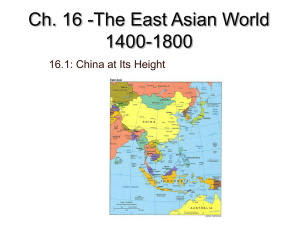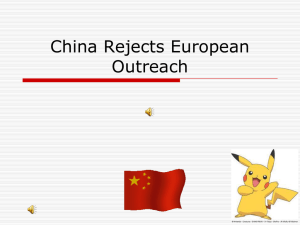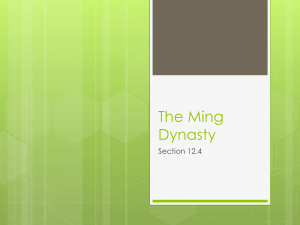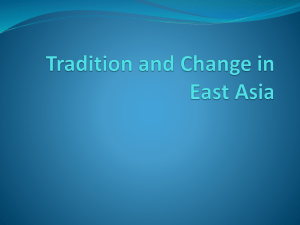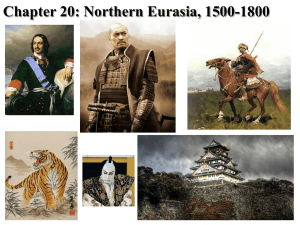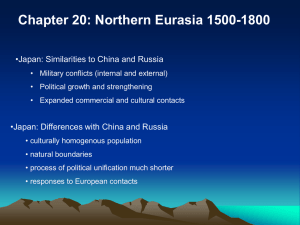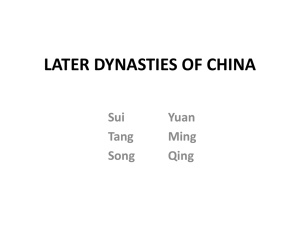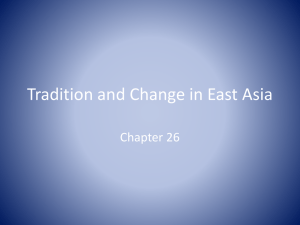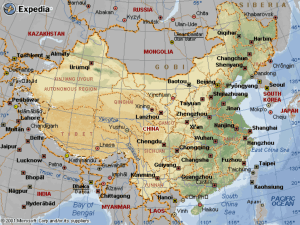Secret World of the Forbidden City
advertisement
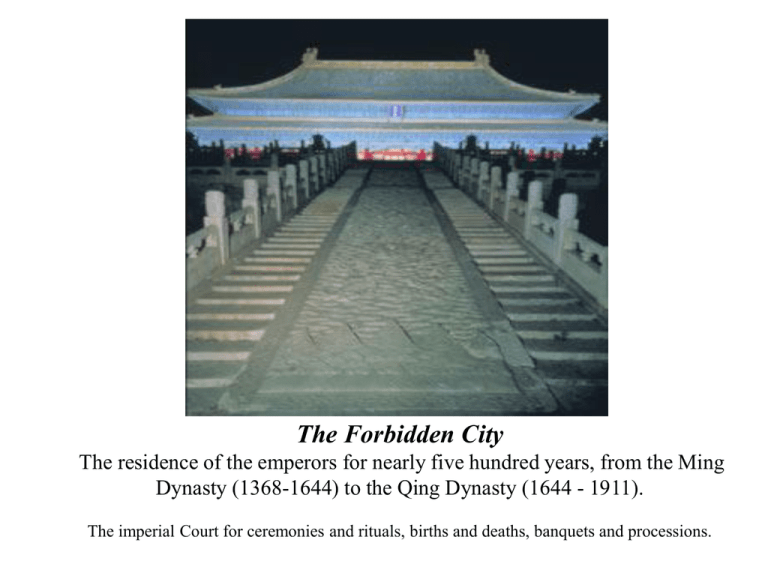
The Forbidden City The residence of the emperors for nearly five hundred years, from the Ming Dynasty (1368-1644) to the Qing Dynasty (1644 - 1911). The imperial Court for ceremonies and rituals, births and deaths, banquets and processions. FORBIDDEN CITY Gates, walls and moat Contains 9,999 rooms. Is surrounded by ten-foot-high walls. Crowned by four observation watchtowers and flanked by a deep moat. Its layout is based on a Chinese cosmic diagram. Watchtower Meridian Gate (The main gate built in 1420) Gate of Supreme Harmony. The square links the two gates. Halls of Harmony FORBIDDEN CITY The Hall of Supreme Harmony (Taihedian) The throne, for important ceremonies: for crowning princes, birthdays, military expeditions. The Hall of Middle Harmony (Zhonghedian), for receiving officials, meetings. The Hall of Preserving Harmony (Baohedian), for banquets and interviews. Halls of Peace FORBIDDEN CITY Hall of Heavenly Peace, front chamber. Emperors attended state affairs daily here. Hall of Union and Peace, keeping 25 jade seals of the imperial court monarchial authority. Hall of Earthly Peace, empress residence. The map History THE FORBIDDEN CITY (1) The Forbidden City was built in the Ming Dynasty, of the Yongle period (1406 - 1420 AD). Many of the buildings of the Palace have been repaired and rebuilt, but their basic form and layout remain in their original state. The Forbidden City witnessed the Qing Dynasty, from the entry into the city led by Li Sicheng to the pinnacle of artistic creativity under Qianlong, to the decline of the dynasty and the abdication of the last Emperor Xuantong in 1912. History THE FORBIDDEN CITY (2) • The Qing Dynasty emperors were descended from the Jurchen horsemen of the northeast of China. • After the decline of the preceding Ming dynasty and the last Ming emperor's suicide, the Manchus occupied Beijing and conquered China. • The majority of the Chinese population, the Han, thus were under foreign rule for the next three centuries. • The Manchus successfully held on to their power by adopting Han customs while preserving their own superior horsemanship along with the Manchu dress. End of Ming and beginning of Qing THE FORBIDDEN CITY (3) • • • • • • • While the Jurchen transformed their social and military organization north of the Great Wall, China to the south faced serious crises. In the 1620s and 1630s, starving peasants struggled to survive by scraping edible bark and by selling their children into servitude. Joined by underpaid soldiers, peasants formed bands to raid towns for food. One of the leaders was Li Zicheng (Li Tzu-ch’eng). In 1644 Li declared a new dynasty, seized the capital of Beijing and designated himself emperor. To avoid the disgrace of capture, the Ming emperor, Chongzhen, hanged himself. A Ming general invited the Manchus to help fight the rebel Li. Taking advantage of the power vacuum, the Manchus captured Beijing from Li Zicheng in 1644 and took control of China. In 1645 they issued orders that made their domination clear: They commanded all Chinese males to shave the front of their heads and to wear a Manchu-style pigtail. The Manchus took over the Ming capital of Beijing as their administrative center. At the time, the city had a population of around one million, which included 10,000 government officials and numerous clerks. History Kangxi (Important Ruler) • • • • The early Qing dynasty owed its success to three extraordinary emperors, who ruled in succession from 1654 to 1796. Emperor Kangxi (K’ang-hsi) was enthroned in 1661, at the age of 7. At age 13 he shrewdly got rid of the regents who were supervising him. In 1670 Kangxi issued the Sacred Edict, which consisted of 16 moral maxims, based on Confucian teachings. He was a Manchu, and an educated, moral leader of Chinese Confucian values. Emperor Kangxi sponsored several ambitious literary projects. Kangxi made it widely known that he not only endorsed the cultural values of the Chinese but had also mastered them. Indeed, through ambitious projects, he showed that he could outperform his Chinese predecessors: – He held a special examination to recruit 50 scholars to write the history of the Ming dynasty. – He set other scholars on a dictionary (Kangxi zidian) that contained entries for nearly 50,000 Chinese characters. – He sponsored the compilation of a library catalog of 10,000 volumes, the Gujin tushu jicheng, which was published shortly after his death. History Yongzheng (Important Ruler) • Kangxi’s son, Emperor Yongzheng, reigned from 1723 to 1735, but accomplished much, especially in strengthening the powers of the monarchy. • He did this by –setting up an inner core of advisers called the Grand Council –developing a secret system of memoranda that bypassed regular bureaucratic channels –warning all scholars and officials against forming factions or political alliances. These measures increased imperial power at the expense of the officials. History Qianlong (Important Ruler) Emperor Qianlong (Ch’ien-lung) reigned from 1736 to 1796. • • • He combined his father’s authoritarianism with his grandfather’s support of culture. He sponsored an enormous literary enterprise that both benefited scholars and kept them under his control. This was the compilation of the Siku quanshu (The Complete Library of the Four Treasuries) These projects provided scholars with rewarding work, but they were also used by the court to find and destroy all books considered harmful to the empire. Decline of the Qing Qianlong’s death in 1799 marks the end of the era of Qing success. Causes include: • Corruption • Over population and the breakdown in government administration. The population grew from 100 million in 1644 to 430 million in 1850. The number of government officials, however, remained constant. The dynasty was ended by Xinhai Revolution led by Dr. Sun Yentsen in 1911. Foreign Invasions • Qianlong poorly understood the changes in the world beyond China. • Chinese trade was limited to one port—Canton. The conflict between British trade ambitions and China’s policy of seclusion resulted in: • The First Opium War (1840-42) that required China to: – – – – open up five ports. pay an indemnity of $21 million to the British. hand over the island of Hong Kong to the British. legalize the importation of opium. The Second Opium War (1856-1860) • Foreigners took advantage of mishaps to increase their demands for concessions from the Chinese. • In 1860 British and French troops occupied Beijing, forced the emperor to flee to his summer residence to the north of the Great Wall, and burned and looted the magnificent Summer Palace outside Beijing. Taiping Tianguo • Much economic suffering and social unrest followed the Opium Wars. • The government had to pay huge indemnities to foreign countries; it lacked funds for social welfare and public works. • At the mid-19th century, several rebellions (Nien, Muslim) ripped through the country, among which was the Taiping (“Great Peace”) Rebellion (1850-1864). – It started in the economically depressed south under the leadership of Hong Xiuquan. – Combining Chinese and Christian beliefs into a revolutionary social program, Hong founded his Heavenly Kingdom of Great Peace in Nanjing. – The rebellion devastated 16 provinces and nearly brought about the collapse of the Qing dynasty. – These rebellions resulted in the deaths of between 20 million and 30 million people. Empress Dowager • • • • Cixi (Tz’u-hsi) Mother of the Tongzhi (T’ung-chih) Emperor Regent when the emperor was enthroned as an infant. Upon his death at the age of 18, she had her nephew made emperor, while she remained regent. Ruled China for almost 50 years. Chinese scholar-officials tried to revive the dynasty by the “Self-strengthening Movement.” – Modernized China’s military forces and manufactured Western-style steamships and weapons. – Set up textile mills, coal mines, iron factories, railroads, and telegraph and electric companies. – Set up schools for learning Western languages and science. Foreign Invasions China’s territory shrank • The French took Annam (northern Vietnam) in 1885. • Germany took over parts of the Shandong (Shantung) peninsula in 1897. • The Russians encroached upon Sinkiang. They annexed parts of the Liaodong Peninsula in 1898. • In 1874 the Japanese raided Taiwan. Japan occupied the Ryukyu Islands and then began to encroach upon Korea. • In 1894 China went to war with Japan over Korea and suffered another humiliating defeat. The Treaty of Shimonoseki (1895) ended Korea’s tributary relationship with China and forced China to: – – – – pay a costly indemnity to Japan, cede to the Japanese the island of Taiwan, open up several ports to foreign trade, and allow Japanese to build factories in China. The Open Door Policy & Yi he Tuan • The Western powers agreed upon the Open Door Policy, which guaranteed them equal rights to trade in China, and further increased their commercial opportunities in China. • The 1900-01 Boxer Rebellion. – practiced martial arts with the belief that, being possessed by spirits, they had a magical invulnerability to weapons. – opposed foreign influence in China, destroyed signs of foreign influence such as railways and churches. Result: the Chinese government agreed to pay to the foreign allies, to destroy several Chinese forts, to allow foreign troops to control the railway stretching from Tianjin (Tientsin) to Beijing. Social Structures The social hierarchy under the emperor was divided into four levels. – The descendents, who inherited Social titles. – The civil bureaucrats (scholar-officials), who earned their positions by passing a sequence of civil service examinations. – Well-to-do educated men, who had passed or hoped to pass examinations but had no official position. – Peasants, 80-90 percent of the population. Women were subordinate to men. “Only women who lacked literary talent were virtuous.” EDUCATION • In theory, anyone who had mastered the classics of Confucius could take the civil service examinations, earn office, and achieve honor. • In practice, members of wealthy families had the best opportunities to prepare for and pass the civil service examinations. • In 1713 Emperor Yongzheng specifically ordered that elementary schools for poor boys be established throughout the empire. • Education was also an instrument of socialization. Arts and Literature • Hong lou meng (1792; The Dream of the Red Chamber, 1929), by Cao Xueqin. It portrays the decline of an elite and extensive family. • , a satire that pokes fun at the civil service examination system and many social customs. IMPERIAL DRESS • • • • The color yellow and the dragon emblem are an exclusive affirmation of power. Emperor Qing’s dress adhered to a rigid code that specified clothing for every occasion. Requisite silks, gauzes, satins, brocades and damasks of the highest quality were woven in the imperial weaving factory in Suzhou, and the clothing was sumptuously embroidered and embellished with gold, pearls and precious stones. The empress had her own wardrobe designed for various occasions. Formal occasions demanded a ceremonial dress, a crown, a single-strand pearl necklace, a double-strand coral necklace, and earrings made of gold and pearls. Useful web site • http://www.yutopian.com/history/qing.html

